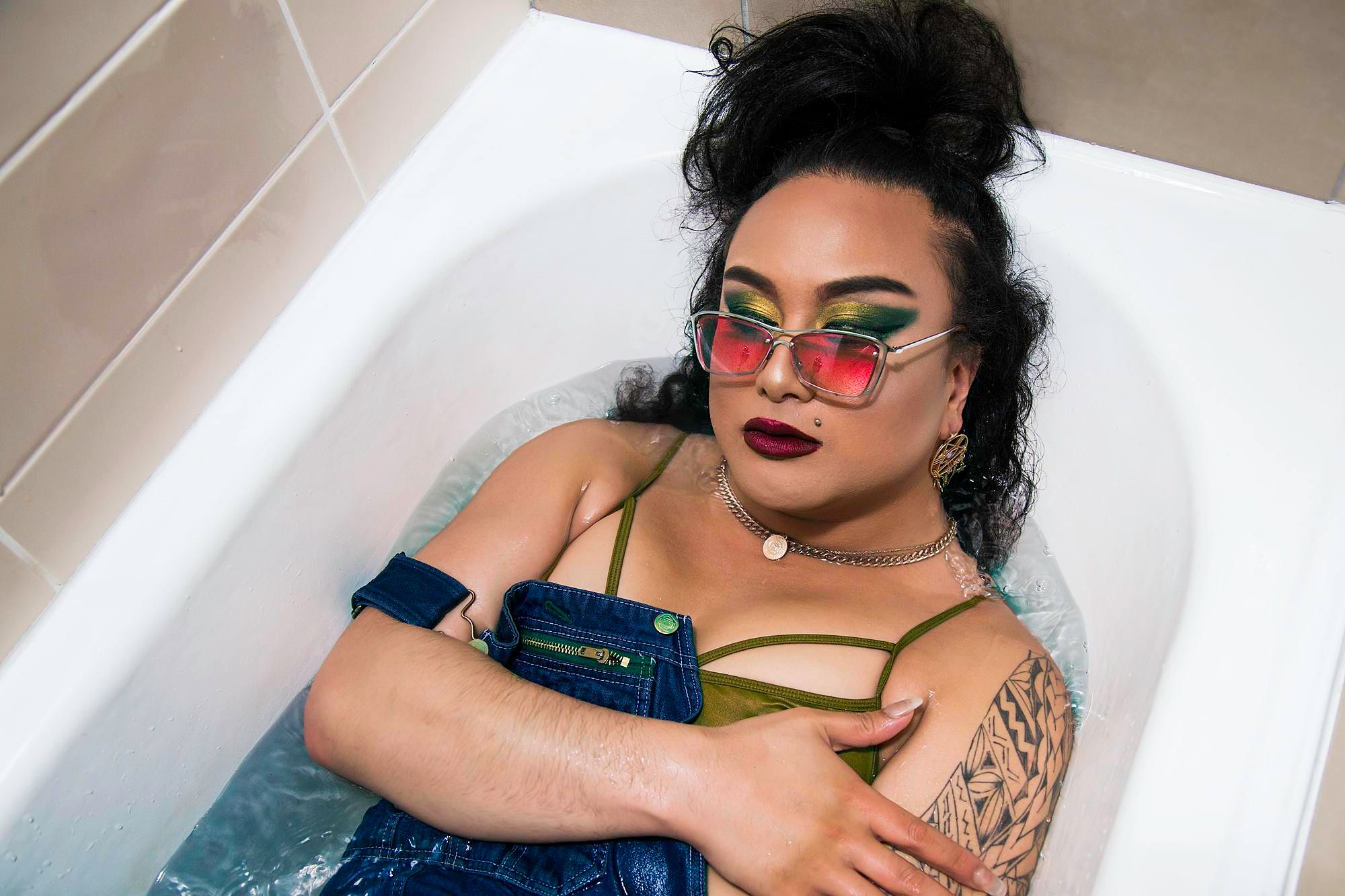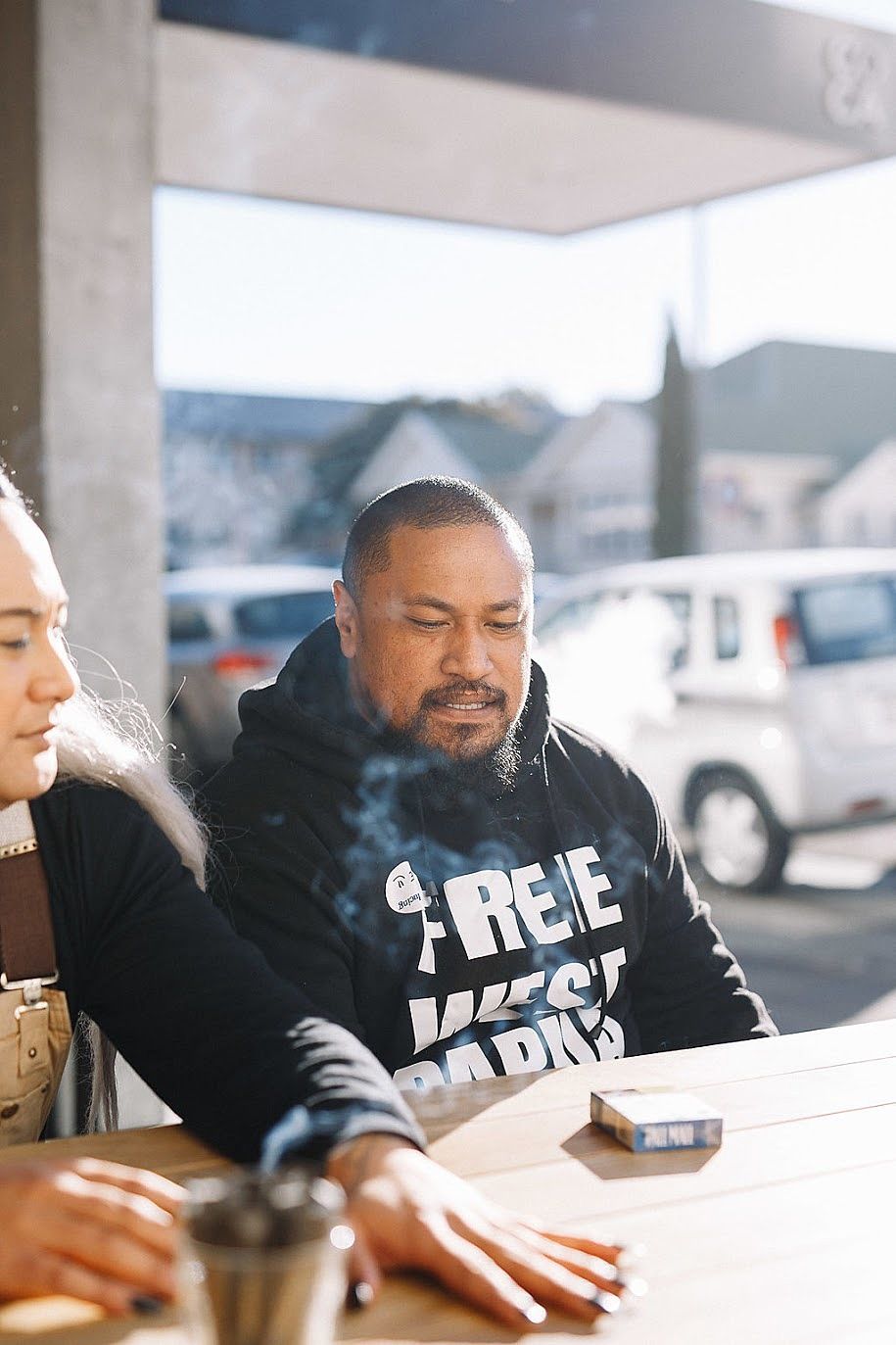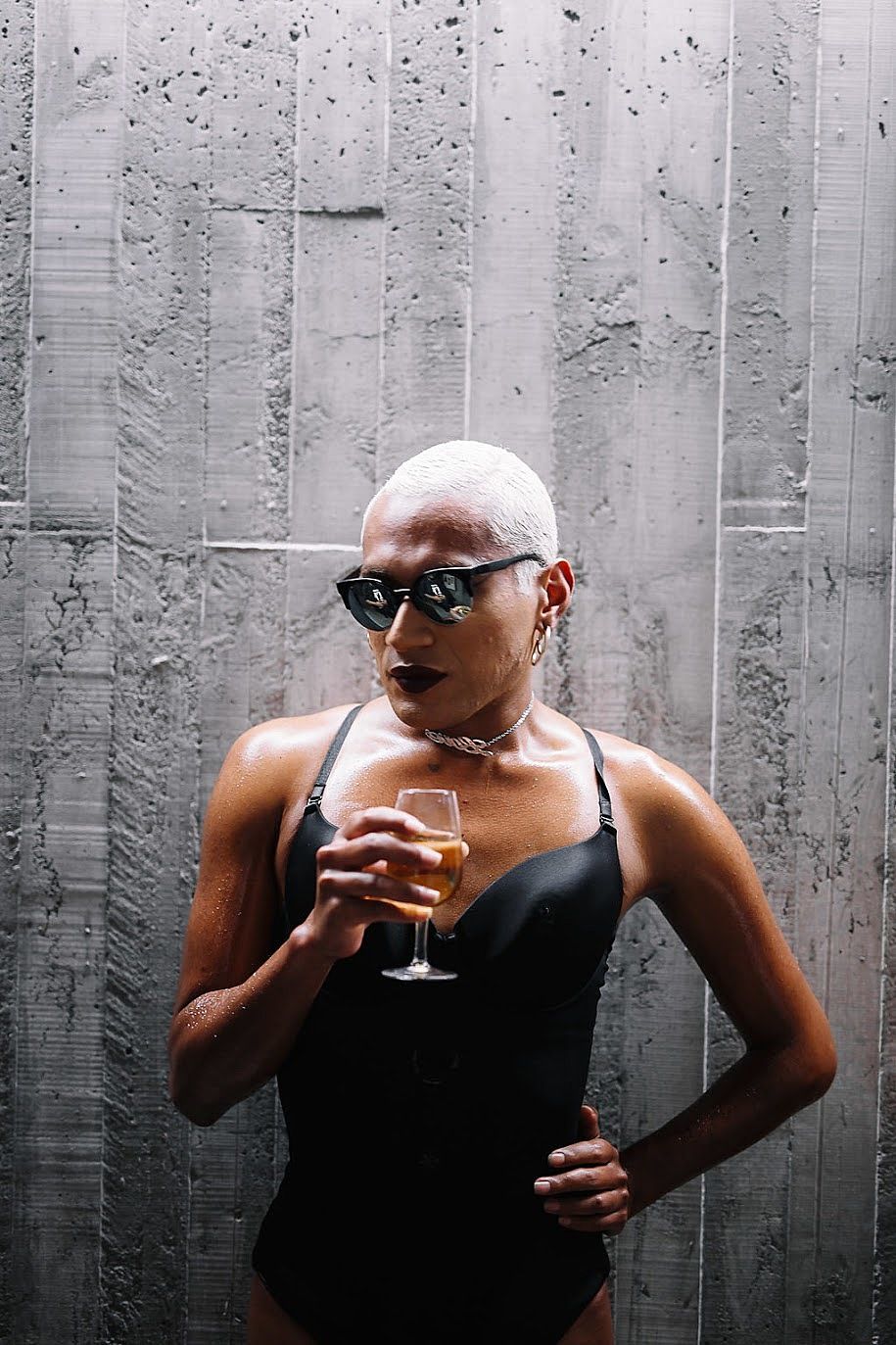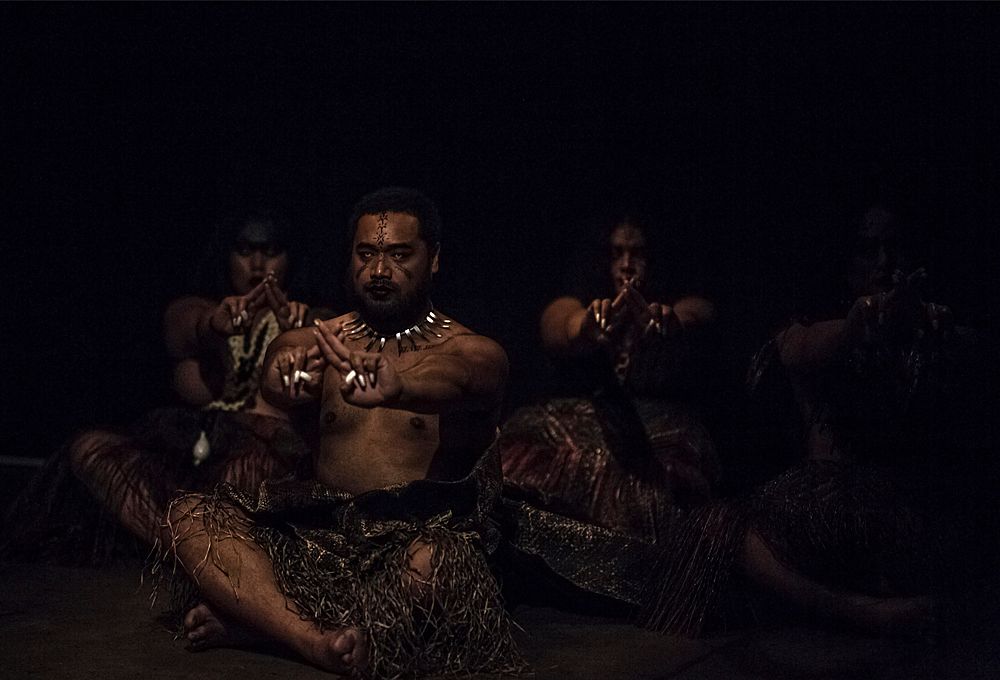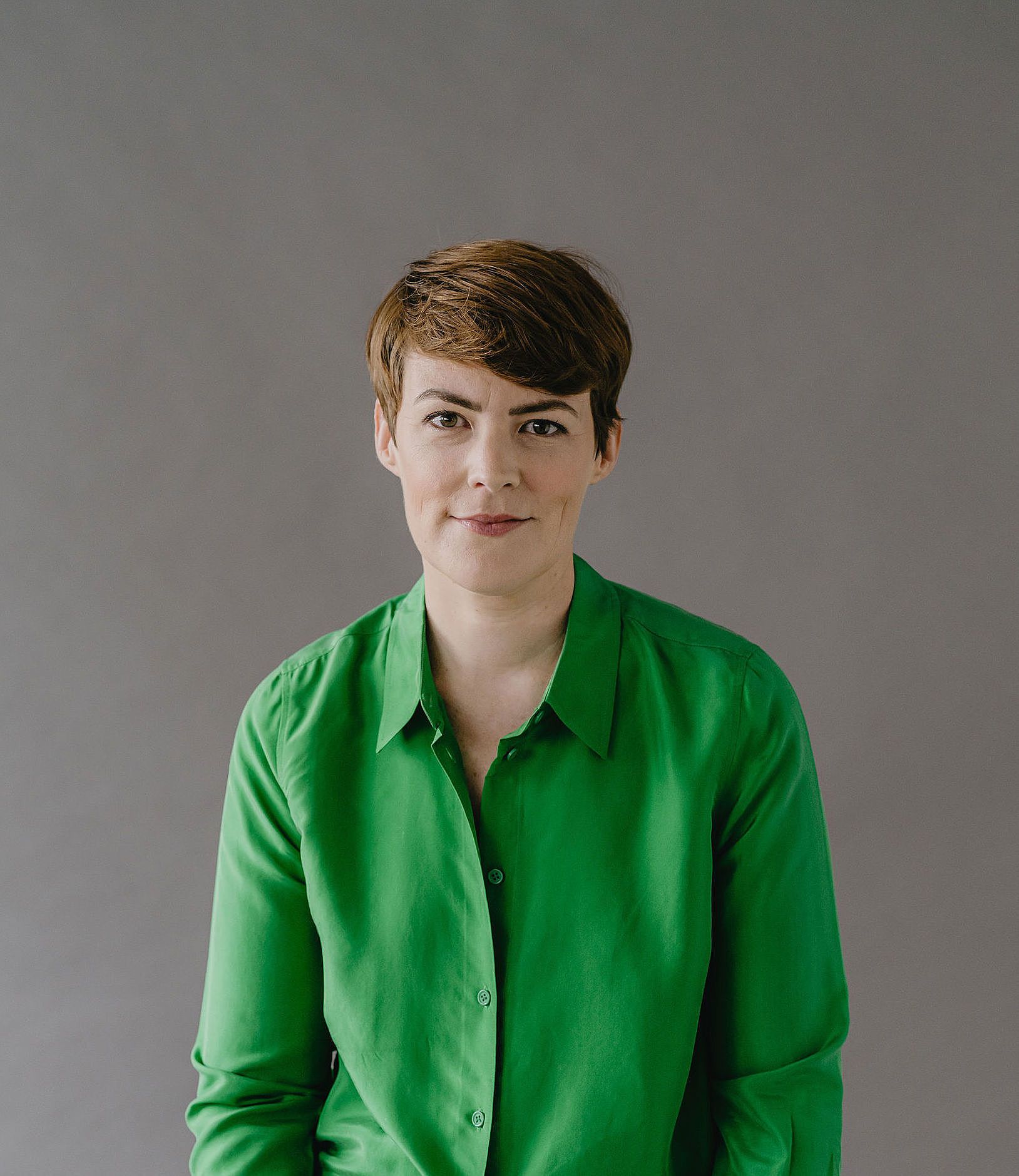We're Here, We're Queer, We're Going Nowhere: FAFSWAG at The Basement in 2017
FAFSWAG have had a big year. As their third Basement show opens tonight, they reflect on their year in the performance space with Kate Prior.
As Neon Bootleg, the third show in FAFSWAG's year-long residency at Basement Theatre opens tonight, Kate Prior sits down with artists Tanu Gago, Pati Solomona Tyrell, Akashi Fisiinaua and Jermaine Dean to reflect on their year at the Basement, how different spaces inflect their work and engaging with new and familiar audiences.
In 2013, the newly-formed collective of queer Pacific artists known as FAFSWAG hosted their first vogue ball in the Te Puke o Tara Community Centre. As a space where Pacific LGBTQI+ young people could come together and be visible, the FAFSWAG vogue balls grew in popularity each year. At the same time the various members of the multi-disciplinary collective were increasingly exhibiting and performing in the city, out South and across Aotearoa, always working within a framework of collective empowerment and resource-sharing. Last year the crew decided to host their first vogue ball in the city, at Family Bar on K Rd.
2017 has been a big year for FAFSWAG. Evolving and refining their work over the past five years has meant a growing audience is becoming conscious of their kaupapa of decolonising Pacific bodies, examining culture through a queer lens, and basically "fucking up the patriarchy." 'Growing audience' is perhaps too mild; it's fair to say FAFSWAG exploded into mainstream awareness this year. You can read about the collective in Paperboy, Art Forum, Metro, and watch their doco on Vice. As a reflection of their artform-agnostic nature, the collective held not one but two residencies at inner-city venues in 2017; one at a gallery (Artspace), another at a performance venue (The Basement).
A growing audience is becoming conscious of their kaupapa of decolonising Pacific bodies, examining culture through a queer lens, and basically "fucking up the patriarchy."
While Last Tapes Theatre Company had an unofficial residency at the Basement last year, FAFSWAG are its first official company-in-residence. Within this, FAFSWAG have mounted three works: Akashi Fisiinaua's Femslick, Pati Solomona Tyrell's Fa'aafa and Moe Laga's Neon Bootleg, which opens tonight. As a collective who often find themselves awkwardly placed as the voice of 'representation' or 'diversity' within Pākehā structures, I was interested to simply hear about the work. What has working in a space more commonly programmed with theatre meant for artists who are always negotiating the permeable line between 'activation' and 'performance'?
Unfortunately Moe Laga, the creator of Neon Bootleg got caught up in rehearsal and couldn't make this discussion. See details of her show at the bottom of this piece.
Kate Prior: It might be good to start by just talking about how the residency at the Basement came about?
Tanu Gago: So we did our first vogue ball in the city and lots of the documentation from that one vogue ball went viral, so lots of people saw it. And [Basement Programme Manager] Gaby was like “I just noticed that you've moved into the city in a really big way and I’d really like to sit down with you and have a chat about the possibility of hosting FAFSWAG at Basement.”
Femslick was a huge success, it felt like it was something that a lot of Aucklanders were kinda looking for and hoping to experience.
TG: I didn’t know it was Gaby who I’d gone to Unitec with until we met, so we did this cute little catch up and debrief about the last six years of our lives. Then I explained to her that there’s a certain commerce attached to the vogue culture in New Zealand – people pay their $10 on the door, and that goes into the prize money for the people who perform on the floor. So that commerce around the event has to function a certain way. So when Gaby said “we have a box office and you book tickets and you get paid out at the end of your season” I said that it’s really challenging to put on an event where that’s the system, because we have to pay people on the night, basically. And so she was like, “Well it doesn’t sound like a vogue ball is ideal for Basement” and I said “Yeah, probably not”. And then she said the capacity was 65 for the studio, and I was like “yeah we have like 400 people who come to these things so maybe that’s not going to work either!”
[Laughs]
Akashi had just kind of informally joined the collective, and I’ll let her talk about her creative pathway, but I was really taken by Akashi’s creative practice, as a graduate from Toi Whakaari. Most of our artists are either graduates from MIT, Unitec or PIPA. So I wanted to know what it was like to collab with an artist who had been training in Wellington for the last three years, so I asked her if she had any ideas of how we could translate this culture of vogue that we’ve been cultivating in our community space into a performance space. So Femslick, which Akashi had delivered in her final year at Toi, became the basis of how we were going to bring vogue culture into that space.
TG: Femslick was a huge success, it felt like it was something that a lot of Aucklanders were kinda looking for and hoping to experience; something different but something that offered more narrative explanation or context to the vogue ball. Because often you come to a vogue ball and it’s just happening in front of you and you don’t always get explained the rules or how it works. But Femslick did this really incredible thing of offering all the context.
So the season sold out, and Gaby was like “if we gave you guys more space to produce more work, what could that look like?” And none of us knew! We were just like, “That’s a great question, how do we answer that question?” And so Femslick kinda propelled us into the opportunity and we’ve been working out what the answer is ever since. The second part of that answer was Pati’s show called Fa’aafa which was originally a cultural activation that toured the country for two years and did two years of development before becoming again translated for the stage and for that space. And now we’re in our final season with Moe, about to open Neon Bootleg, which is again just another opportunity for the artist and the company, or the collective, to really explore the types of stories they’re interested in sharing with people. So that’s kinda how the residency came about.
KP: It’s so clear there that you can’t extricate that economic conversation from the work that you’re making, in that the seed for the residency was going “well the commerce of the vogue ball doesn’t work in the risk-share context of this theatre, so what can we make for this economic context?”
TG: Yeah. Well this is the thing – in the collective we’re constantly problem-solving and this is what I feel makes FAFSWAG as a brand so innovative.
KP: It’d be really great to pick up on your individual practices. You mentioned that idea of translation, and maybe that’s a good way in to talk about each of your work through the year. For you both, Pati and Akashi, your work has existed in other spaces, so when you’re working through that act of translation for a theatre space, what are some things that you consider?
Pati Solomona Tyrell: I guess I should talk on the experience of activation in terms of audience, and the reciprocation of energy from artists and audience. I had another experience elsewhere doing Fa’aafa where I guess the distance from my audience and not being able to see faces or anyone there really disconnected me from my work. When I get into the space it makes me think about how I want my staging. The traverse staging at the Basement really worked for me because we had the audience on both sides and were able to feed off them.
TG: I think one of the first things that needs to be negotiated is the concept of audience and how audience works in relation to our practice, because we have practices that require active audience. You can’t come and passively consume, you can’t come and be a bystander, you have to participate and you have to invest a lot of personal energy because the performers are also giving you that. We have to be clear about that with the venues. We have to say to them that this is our indigenous model of practice and this is uncompromised – we can’t shift it purely for the sake of entertainment. [To Akashi] What does it look like for you? The translation?
Akashi Fisiinaua: A major thing for me was also this idea of risk. It’s a concept that has been chucked around in the art and performance industry: who are you speaking for? What are you risking? I always want to feel like there’s a political or personal agenda always at risk because it then just makes the work more alive and I never want to be asleep, like ever. After [training at] Toi Whakaari there was a need for me to see myself reflected in the kinds of work or the kinds of media I was surrounding myself with, either theatre or music videos or whatever. I don’t really care for ‘theatrical’ because I wanted Femslick to be authentic to my experience of ballroom culture. I think we’re just living in a culture where everything is 30 seconds long and a theatre experience or activation experience is different; it requires you to focus, it requires your attention and I never for one second want to create a piece of work that is anything other than that.
Often when we do big festival projects they’ll have a media company come in and try to translate our brand into something palatable and consumable for Susan and her husband and her nuclear family in the North Shore.
KP: So the beginning of the creation of Femslick was in your third year at Toi Whakaari?
AF: Yeah the beginning of Femslick was at Toi Whakaari and it came out of just frustration. I just wanted to link up with some cool people and get real excited about shit that I thought was cool, but then all of these motherfuckers were just like “oh nah, you’ve just got to do A to B to make a successful career”.
KP: Yeah right. I went to Toi Whakaari.
AF: Did you?
KP: 2004 I graduated, so quite a while ago. But I remember those people too, who at 20, very clearly knew they had Shortland Street in their sights…
AF: And it’s just like, “why sis, why?” We live in such a technological era – there is technology and information at our disposal so why not push the fucking boundaries, like why not?
TG: I also think it’s really important to be clear that the criticism of our creative industries and the creative institutions that we’ve all been embedded in, isn’t to take away from people who for them, that’s their dream, they want to be on Shortland Street. There’s nothing wrong with that. I think what we’ve collectively noticed and what we have in common as artists is that we’re just seeing ourselves reflected in an authentic way. So we all do this process of decoding our practices and the spaces where they exist.
KP: Yes. And what do you mean by decoding?
TG: Part of our collective practice is decolonising contemporary art practices. The models that are designed and developed are western models that are created for the majority which is Pākehā. So to use marketing as an example – often when we do big festival projects they’ll have a media company come in and try to translate our brand into something palatable and consumable for Susan and her husband and her nuclear family in the North Shore and we’re just like, “if you tinker with this too much, you’re going to take away the essence of what it is because you’re trying to make it something that it isn’t”. Also, maybe your agency should go and do some research around how to market to Pacific audiences and how to market to queer audiences instead of us having to facilitate this educational process. Because that’s not part of our practice – we all know how to do it but it’s not our jobs. But if we don’t do it then you’re going to fumble it.
KP: What I love about your own work is that it feels like your work and your messaging about your work is one and the same, and it’s so strong. It’s not separate from what the work is.
TG: It’s all one. It’s a very holistic way to look at creative process and creative career as well, because we’re all doing those bits and pieces, we’re designing an experience or a cultural narrative so to speak, that is full-bodied and not just the parts that we like. We have to also talk about the parts that we don’t like or that make us uncomfortable. Especially in Pati’s work – his Fa’aafa was a huge response to colonisation.
Because I know my identity so well, when it’s presented on the wall, it feels really bulletproof to me, so your voyeurism and your tendencies are almost irrelevant or rendered powerless.
KP: And I guess it comes back to that question around translation. Because a theatre can have a particular audience/performer relationship, it can sometimes move into those awkward spaces of voyeurism. Is that something that you’re aware of as well when you’re in those more predominantly Pākehā spaces, like the Basement?
TG: From a visual arts perspective, just for myself personally, because I know my identity so well and so thoroughly, when it’s presented on the wall, it feels really bulletproof to me, so your voyeurism and your tendencies are almost irrelevant or rendered powerless. Because I know who I am and I can exist in this space, and you can still be a voyeur and you can stare at me and take something from me, but I can still command that space.
AF: And it’s about being authoritative in those spaces – that’s when you remove power from that structure. It’s saying “I’m here, I’m queer, and I’m going nowhere”. But I always feel empowered within those spaces to push an agenda because that’s what I’m doing as a practitioner always.
KP: Yes!
It’s about being authoritative in those spaces. It’s saying “I’m here, I’m queer, and I’m going nowhere”
In terms of audience, do you feel with both Femslick and Fa’aafa that your core audience came as well as a new audience? Or was it more a Basement audience who were totally new to it?
TG: Pati’s got this crazy loyal following…
PT: I think I had a good mixture of all three; our core audience for FAFSWAG, Basement’s audience and the social media audience from which I have a really good support base of fans.
KP: Have you got a massive social media following?
TG: Yeah he’s got groupies.
PT: Not groupies, nah, but there’s definitely a support base from Twitter and Instagram. Especially this group of young Pacific mothers who always come support my work. So yeah, definitely brought our audience. I feel like the majority of audience was our people; our Pacific community, our creative community and then our online base.
TG: We have friends who are like “we only come to the city for you guys”. There are members of our online audience who feel like they wouldn’t typically venture out of the suburbs and into the city to see a piece of theatre because that’s an uncommon practice amongst our people as well.
AF: The investment of our people in theatre is normally like the typical stories – the musicals or the popular Victor Rodger plays (shout-out to them). But also the gimmicks, the stereotypes. This is what our people like to watch – the dehumanisation of trans bodies on stage and making them a laughing stock. The parodies.
KP: What’s an example of that?
AF: Aunty Tala.
TG: Aunty Tala’s probably the most widely accepted caricature of a fa’afafine because Aunty Tala’s now mainstream – she’s part of a Smokefree campaign. So now even the mainstream culture get to use this inappropriate caricature trans person to sell you a health message. So this is the thing of, as a community we don’t see ourselves and when we do, it’s a man in a fucking dress who has the cheek to tell me not to smoke. Like, get away!
PT: Yeah I went to one Pacific theatre piece and there were three queer characters and they’re all the same, they’re all one dimensional stereotypes, loud and obnoxious and dumb and had to be funny.
TG: When we talk about being marginalised and being invisible, these are the things we’re talking about because they become staples in our culture and totally looked over and acceptable and for us, we sit on the other side and we think about how dangerous these representations are because heteronormativity kills. It is literally making it acceptable for everyone in our culture to participate in this laughing process of reducing a person’s entire identity into a punchline, into a gag, and it’s the same gag they use every time. And they teach this to children and this is where the toxic stuff starts.
Our inbox is stacked full of messages asking us to come and FAFSWAG and we don’t even know what that means, we’re all just like “What the fuuuu...?”
PT: Yeah it’s true, when I was younger, I just remember whenever we’d have these family events and they needed performance, I was often used, my femininity was the gag, it was the punchline for the performances. And it got to the point where eventually I started understanding these things and they’d ask me again and I was like “ah, I’m alright, I don’t want to be the funny part, can I just dance with the rest of you? Can I just be?”
TG: You get prodded in the ribs, like “Do something funny, be queer and be funny”. That’s what they’re saying to you.
This becomes an overarching thing for FAFSWAG because then FAFSWAG as a collective get asked by the wider community “Can you come dance at my son’s 21st?”
AF: Can you come do some FAFSWAGing?
TG: Yeah, whatever that means – come and FAFSWAG for us.
PT: Can you FAFSWAG for us?
KP: As a verb?
[Laughs]
PT: We actually get that as a question.
TG: Our inbox is stacked full of messages asking us to come and FAFSWAG and we don’t even know what that means, we’re all just like “What the fuuuu...?”
But I think it’s important. We talk to our artist friends who are like “Don’t you think it’s a bit OTT that you guys had to commit to three projects in a year?” [as part of the Basement residency]
KP: That was a question I had too, yeah.
TG: In terms of sharing the workload, it seemed really manageable, so it didn’t seem that overwhelming or unrealistic to achieve. Often what you see happen is some queer narratives come along once every couple of years, and they’re really sophisticated and they deliver this really potent message, but then the energy is lost and there’s always this reset process that happens, and I was like, it can’t just be Femslick, we have to be creating consistently, because in the time in-between, people forget and you have to remind them again. And so we’re always really driven by that political responsibility and that social responsibility to be here and do this properly. We’re all invested because it’s our lives – those are the stakes in terms of investment.
KP: Yes which relates to your point about stakes earlier Akashi – these are ours and I expect the audience to meet us there.
KP: So 2017’s been a massive year for you all, not only in this residency, but also your own practices as well. Has that been challenging?
TG: From a resource side, yes. In terms of making and the creative aspiration, no. It’s been so exciting and rejuvenating. But the resources in New Zealand suck, man. When we finally figured out what people actually make from a box office, even from a sold-out successful show, we were like “Oh my god, why do people do this, is that what you make? Ok, this clearly isn’t the place where we’re going to become rich and famous but we’re here and it’s important, let’s do the work.”
KP: Was it striking to you coming from other art forms that that’s the level in a risk share theatre?
TG: Yeah! That’s how everyone in the industry just works, and they’ve accepted it, and I just feel like in any other industry where we would get shortchanged like that, it would be criminal, you know?
KP: Do you mean in any other art industry or do you mean –
TG: Any other industry industry, but I think in the arts, it’s kind of common, even in the visual arts. The abuse of the word koha, and the things you can ask people to do as long as you pop that little word koha in there. The value system in the arts is totally disproportionate.
And because people come to all the vogue events, they feel like the FAFSWAG conversation is not a sophisticated one until they sit down with us for five minutes and are like “Holy shit, you guys are for real” and we’re like “Yeah it’s not all just singing and dancing and throwing our bodies across the room, there are some real conversations here.” It’s great to do these things and to have consistent visibility in our industry but at some point we want the means or the resources to be able to do it permanently, indefinitely.
And so when we talk of actiVAtion, it’s not a performance, it’s not for entertainment, this is channeling something that is sacred.
KP: Could we maybe just chat about the concept of va and that protocol, and negotiating the line between what is activation and what is performance?
PT: So yeah, actiVAtion was coined by artist Rosanna Raymond and it comes from the Samoan concept of va which is the idea that the space between people, and the space between people and objects and space, is sacred and alive and not something that is...
TG: ...void of life or energy.
PT: And so when we talk of actiVAtion, it’s not a performance, it’s not for entertainment, this is channeling something that is sacred. I think [va] has its own space. I wouldn’t consider it performance at all.
TG: So when spaces or curators are asking us to come and perform, when they ask the performers to perform we say “oh cool”, but when they ask the activation artists to perform, it becomes a really intense conversation and we have to again decode our processes for people. And so Fa’aafa started out as a solo activation that Pati performed – activated – himself. See, even the language becomes super complicated. But we try to exercise that language because it’s like pronouns – they’re important, you need to get it right. So that’s how we think of the term activation – in relation to those other kind of languages that are important for framing our identities.
KP: And the word 'performance' sits outside that for you?
TG: Yeah because the consequences of a performance are different. The relational politics as well. This is where that thing you mentioned about voyeurism and subversion, that’s where I feel like those things relate to performance. They’re rendered powerless in an activation. Because the activation is operating of its own knowledge and its own essence.
KP: I was wondering if there was any curatorial vision over the whole season? But I imagine it’s also very much about what the individual artist is exploring.
AF: Well doing Femslick in its context of Pride [Festival] was about making space for people like us, so it was like body heavy, all about self defence, all about putting our bodies on the line. And then to watch Pati take over the space, it was very spiritual and about the connection that he had with his culture. So I think the trajectory [of the residency] has been a very organic process of going from body, to spirit, to personal, which is where Moe’s show fits in. For me, being on the outside looking in, it follows this narrative.
TG: We knew that they had to be different but we were also aware that there was enough personality and personal experience to distinguish them all individually.
Fa’aafa for me was this concept of half, and being in-between, whether it was in gender, or the physical and spiritual worlds. So I pulled from the past – this thing of looking back into the past and walking backwards into the future.
PT: We’ve all got our style so you totally see the different aesthetics; [to Akashi] your banjee cunt vogue aesthetic was really there in the way you dressed your cast, and then the same with me where I continue my visual practice. And I feel Moe’s one will definitely have its own look as well.
KP: How do you describe your aesthetic?
PT: Fa’aafa for me was this concept of half, and being in-between, whether it was in gender, or the physical and spiritual worlds. So I pulled from the past – this thing of looking back into the past and walking backwards into the future. So that’s how I kinda create my visual aesthetic, taking material – the silhouettes from portraits of Samoans back in the early 1900s – and transporting that. So my thing is all about reclaiming and reintroducing culture and the visuals back into the present in order for our people to see it again and give it a second life, I guess. Or just a reintroduction for them into something they’ve never seen before.
KP: When I saw it, I’ve never experienced an audience to just stay in a space, quiet, for so long afterwards. It was beautiful – no one wanted to leave the space that you’d made.
PT: For me it was really important – I just want the audience to be transported into the realm of where Fa’aafa exists. And I think I was really successful in that. A lot of people came out of it saying it was really meditative.
KP: Which is almost the opposite of Akashi’s?
PT: But at the same time the same energy, just controlled differently.
KP: Yes.
PT: I could see the pulsating that [Akashi] had was very out there, but Fa’aafa contained it within our bodies and put that space between us and audience – that’s where that energy was held.
TG: Very few people knew that Femslick was part of Akashi’s graduate thing at Toi, they thought that it came out of nowhere. A lot of people didn’t know that Fa’aafa was a solo cultural activation that’s travelled all over the country and featured in a whole lot of publications and debuted at Pah Homestead as part of the 2016 Pride. It’s had so many lives and identities that I felt like lots of audiences were kinda spoiled to come in at its current form. In saying that, it could still do with a professional development workshop to get it into that real slick form.
I guess my point that I’m getting at is that these projects are so much research, and so much time and energy and love has gone into them. So although they were designed for the Basement and the residency, it’s been a long road to get them there. And the thing with Moe is that she’s just spent six years on stage and in front of the camera and she’s had so much experience telling other people’s stories that I’m really excited to see her personal journey. And she’s been super top secret about it, this is her process, and I feel like we’re going to be quite surprised on opening night when we get to see it. Which is great for us because usually we’re all so transparent with our creative processes – we get to cute little previews before things so we kinda know the temperature for everything. But Moe’s got her own director, she’s handpicked her own team of people that she trusts because it’s such a personal story. And they’ve been working really hard and really tirelessly on this collaboration.
Neon Bootleg runs from 21-25 November at the Basement Theatre. Tickets available here.
